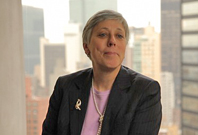 "There is a lot of variation in donors’ motivations and approaches to philanthropy," says The New York Community Trust (NYCT) President Lorie Slutsky. "Some are motivated by data, others by personal experience; some want impact, some just want to give back." Partly because of this, she says that community foundations are uniquely positioned to help communities by aggregating the funds and blending the interests of many donors, and by having on-the-ground knowledge other kinds of foundations rarely acquire.
"There is a lot of variation in donors’ motivations and approaches to philanthropy," says The New York Community Trust (NYCT) President Lorie Slutsky. "Some are motivated by data, others by personal experience; some want impact, some just want to give back." Partly because of this, she says that community foundations are uniquely positioned to help communities by aggregating the funds and blending the interests of many donors, and by having on-the-ground knowledge other kinds of foundations rarely acquire.
Experts on New York City
Slutsky says that through the NYCT, she and her team create something that is greater than the sum of individual donors' causes. "Our goal is to focus on the community," she says, and points out that this focus on the Greater Metropolitan Area of New York is accomplished by providing donors with a skilled, consistent staff and board to ensure their donations are spent wisely. Slutsky says that the foundation has about 2,700 individual charitable trusts that aggregate to the foundation's endowment, of which there are about 2,000 living donors.These endowments represent a range of interests and causes. For example, "Mr. Smith" might be interested in arts programs for children, "Mrs. Jones" in public education, and another donor may be interested in improving the quality of life for New Yorkers. "Some have very narrow interests and we have some very narrow-purpose funds," says Slutsky. "Those are field-of-interest funds and the real role of a community foundation is to weave them together in a way so that the whole is greater than the sum of the parts—so I can combine Mr. Smith's interest in arts education for children with Mrs. Jones' interest in public education and improve arts programs in the public schools, for instance."
See a complete archive of Lorie Slutsky's videos.
Collaborating across the city
That collaboration extends to donors of all kinds, teamwork that's rare in the philanthropic world. Because of the "deeper bench of staff," the NYCT can be "a great partner for small family foundations, individual donors, even large national foundations who don’t have a strong local presence in our community," says Slutsky. "We can collectively come together, garner more resources than any of us individually could." One example of such a partnership is the Donors’ Education Collaborative, a joint grantmaking effort of a number of New York funders that Slutsky says was created in the 1990s to collectively address public education. Since its creation, a number of foundations have come together to invest more than $14 million in projects that "combine constituency building, policy research and development, advocacy, media campaigns, negotiation, and organizing to achieve reform," according to the NYCT website.Tackling unpopular issues
Philanthropists are often in the position to tackle change what others can't—or won't. Such is the case for The New York Community Trust. While some organizations rely on "on the spot" generosity to fund work, the NYCT can rely on its endowment to focus on what matters most—even when that focus is unpopular. For example, when AIDS was still considered a disease that did not have mainstream relevance, the NYCT applied funds that had been entrusted in the 1940s to work on cures for blood diseases. "And AIDS," says Slutsky, "is fundamentally a blood disease.""You can't be an effective community foundation trying to respond to community problems if you only respond to the ones that everyone agrees are OK," says Slutsky.


